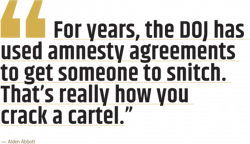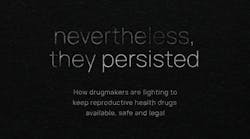When federal prosecutors are breathing down a company’s neck, it’s not often that executives opt to wait and see how the whole situation will play out in court. The stakes are just too high, especially in criminal cases when penalties can be severe and executives could even get carted off to jail. Thus, the common legal wisdom is to settle — and settle fast.
So when Teva Pharmaceuticals walked away from settlement talks with the U.S. Department of Justice (DOJ) over criminal charges related to widespread price-fixing allegations, eyebrows were raised across the industry.
“I was surprised when Teva chose not to settle because of the huge consequences involved…and the danger of going in front of a jury,” Rachel Peck, an attorney with Steptoe who specializes in white collar defense, cartels and antitrust issues, said.
But the company, it seemed, had some cards up its sleeves. It was the spring of 2020, and with the pandemic raging, Teva reportedly gambled that the federal government would not levy charges against one of the largest companies involved in supplying needed drugs. In fact, Teva had recently announced that it was donating 10 million tablets of hydroxychloroquine to wholesalers — a drug that, at the time, was still being lauded as a potential “game-changer” in the pandemic fight. The message? Teva was a government friend — not a foe.
The bet, however, didn’t pay off. In August 2020, the DOJ formally charged Teva with conspiring to fix prices, rig bids, and allocate customers for generic drugs. According to the DOJ, consumers were overcharged at least $350 million, and unless Teva ultimately settles, the indictment has set up an eventual showdown in court.
It was the latest twist in an ongoing and large legal saga that has rattled the generics industry — often portrayed as the do-gooders in pharma. Although it started with a trickle of price-fixing allegations in 2016, it has since erupted into a flood of lawsuits targeting dozens of companies for allegations related to hundreds of generic drugs. And the lawsuits piling up around the industry now include state-led, class action and criminal litigation efforts.
Teva, which released a statement after the DOJ indictment saying that it rejected the charges and that it will “vigorously defend” itself in court, has been pitted as being at the center of one of the price-fixing conspiracies that allegedly permeated throughout some of the industry.
Yet, the charges speak to deeper problems that have boiled beneath the surface of the generics landscape for decades. Now, as the industry takes stock of how the various lawsuits are unfolding, generics companies may find themselves adjusting business practices to avoid further allegations. And the situation is opening up the door to talk about larger issues that could be creating the perfect environment for price-fixing schemes.
Clouds of collusion
The backdrop
Since the price-fixing allegations in the generics industry exploded in 2018, the situation has oft been referred to as the “largest cartel in U.S. history.” But this isn’t the first time that pharma companies have found themselves ensnared by allegations of widespread price fixing.
In 1999, the DOJ settled two major antitrust suits related to vitamins — one of most commonly used health care products in the country. According to the suits, major manufacturers colluded to artificially inflate the prices of vitamin supplements and additives used in processed food products. It was a situation that then Attorney General, Janet Reno, said impacted “every American consumer” on a “daily basis.”
After Rhone-Poulenc SA, a French vitamin-maker, agreed to cooperate with the DOJ in exchange for avoiding prosecution, the case resulted in a $500 million fine being levied at Roche, and a $255 million fine for BASF. At the time, these were the largest antitrust penalties in U.S. history. The former marketing director of Roche’s vitamins division also had to pay $100,000 and was sentenced to four months in prison.
The harsh penalties were indicative of the DOJ’s efforts to beef up antitrust enforcement.Since then, a number of other industries, including construction supplier companies and major meat processing corporations, have been rocked by widespread price-fixing lawsuits and settlements. Although the impacted industries operate in vastly different markets, they all have one thing in common: identical and interchangeable products made with low profit margins.
“Cartels are hard to form when you have firms making different goods with different levels of quality, because there are all sorts of dimensions you have to squabble about. The raw materials may change, the costs may go up and down, etc.” Alden Abbott, a senior research fellow at George Mason University’s Mercatus Center, and a former Federal Trade Commission attorney, says. “This is why it’s not surprising to see cartel conduct in a homogenous goods industry.”
According to Chester “Chip” Davis, president and CEO of Healthcare Distribution Alliance and the former president of the Association for Accessible Medicines (AAM), the generic industry’s largest trade group, it’s a situation that can be traced back to the Hatch-Waxman Act — a regulation passed in 1984 to help propel competition in the generics space.
In the beginning, there was no question that Hatch-Waxman succeeded in streamlining approvals and bringing more generics to patients — a change the marketplace embraced. Yet, as Davis explains, unforeseen consequences later cascaded through the industry as the dynamics of the market shifted.
“Fast forward in time and you have major health care consolidation among pharmacy benefit managers, distributors and other buyers,” he says. “So that original intent of Hatch-Waxman, where you have 12-15 different manufacturers and countless buyers hasn’t stuck as the number of buyers has dropped significantly. And do you really need 12-15 different manufacturers to get down to commoditized pricing? Many health care economists would tell you that you need about three to five to get down to that pricing. So I’m not sure that the health care system has appreciated how much the market has changed.”
A race to the bottom
On top of that, political and public pressure in the generics space to keep prices low has created an environment that Robert Field, a professor of law, and health management and policy at Drexel University, says could lead to “temptation to artificially inflate prices.”
“There’s a conflicting policy goal,” Field says. “We want the generics industry to be as robust as possible, but when you ask them to operate with these thin margins, there’s going to be a risk of engaging in behaviors such as price fixing.”
Given the diverging forces at play in the generics market, Patrick Linehan, a partner at Steptoe who specializes in white collar defense, cartel, and securities issues, says that it was only a matter of time before antitrust behaviors came to light.
“I’m surprised it took this long for an investigation [into price fixing] to surface,” Linehan says. “The generic drug industry is ripe for this type of activity because you are dealing with interchangeable goods and the competition is based on prices, not unique aspects of the products.”
Where the suits stand
In one of the first major exposés of the price-fixing allegations, a December 2018 article in The Washington Post painted a sinister portrait of antitrust behaviors by generics companies.
Citing investigators involved in the probe, the environment was described as a “sandbox” where companies played nice with each other and divvied up the market for certain drugs. Over dinner, cocktails and rounds on the golf course, companies allegedly used a form of shorthand to communicate about how they would work together to share the market and inflate prices.
At the time, the investigation, being led by the attorney general’s office in Connecticut, involved over a dozen companies — including Mylan, Dr. Reddy’s Laboratories, Teva and Sun Pharmaceutical Industries. In a court filing, Teva said the allegations of conspiracies were “devoid of any facts.” But two former executives at Heritage Pharmaceuticals — also named in the investigation — then pled guilty to federal criminal charges and have since agreed to cooperate with the DOJ.
This approach to unraveling industry-wide antitrust behaviors follows typical investigative patterns.
“For years, the DOJ has used amnesty agreements to get someone to snitch,” Abbott says. “That’s really how you crack a cartel.”
The probes led by Connecticut’s attorney general have now resulted in three multi-state lawsuits filed in 2016, 2019 and most recently, in 2020 with a focus on topical drugs. All told, the multi-state suits have named over 30 pharma companies as defendants along with dozens of industry executives. And given that every state is now involved in at least one of the lawsuits, it is one of the most far-reaching antitrust legal efforts in U.S. history.
“The scope is huge” Abbott says. “But the fact that all 50 states are involved is not surprising given that generic drugs are a big ticket item across the country.”
Although the initial multi-state complaint named Heritage Pharmaceuticals as a “consistent participant” in collusion, the 2019 lawsuit placed Teva at the heart of the conspiracies.
“At the zenith of this collusive activity involving Teva, during a 19-month period beginning in July 2013 and continuing through January 2015, Teva significantly raised prices on approximately 112 different generic drugs,” the complaint alleges. “Of those 112 different drugs, Teva colluded with its ‘High Quality’ competitors on at least 86 of them (the others were largely in markets where Teva was exclusive). The size of the price increases varied, but a number of them were well over 1,000%.”
Despite the evidence presented in the complaints, settlements with states have already begun. In June, Teva struck a deal with Mississippi to put the issue to bed for $950,000. As part of the agreement, Mississippi said it would no longer seek action in the multidistrict litigation against Teva — a conclusion the company cheered.
“We believe the modest settlement amount reflects our position on the lack of evidence for the allegations against us,” the company stated.
In addition to the multi-state lawsuits, some generics companies are also facing proposed class action suits from purchasers, shareholders and patients.
And, of course, there’s the situation with the DOJ. In addition to its charges against Teva, six other companies and four executives have been slapped with criminal charges by federal prosecutors. Of those accused, five companies — Taro Pharmaceuticals, Sandoz, Rising Pharmaceuticals, Heritage Pharmaceuticals and Apotex — have entered into deferred prosecution agreements and have agreed to pay fines and cooperate with the investigation.
But like Teva, Glenmark — another company accused — has held out on striking a deal with the DOJ and both companies have vowed to continue fighting the charges.
On the defensive
On an investor earnings call this February, Teva’s CEO, Kåre Schultz quipped that if there was price rigging in the industry, it would be the “worst cartel in history” given that prices for generics in the U.S. are lower than they are in Europe, according to a study by the RAND Corporation.
Through it all, Teva has continuously pushed back on price-fixing allegations, pointing to overall pricing trends in the industry as evidence that widespread collusion hasn’t occurred. Glenmark has presented a similar defense and argued that the charges lack merit.
“We strongly disagree with the charges being advanced by the Justice Department and do not believe the evidence supports the government’s case,” a Glenmark spokesperson told Informa Pharma Intelligence’s Generics Bulletin in July 2020.
So far, neither company has responded to specific allegations made in the various legal complaints, but Field says that if they do head to trial, Teva and Glenmark could argue that their behavior did not impact prices.
“The most common defense would be that it didn’t affect competition,” he says. “On the other hand, the rule for price fixing is really strict and straight-forward.”
“If you see an agreement of price fixing, it’s illegal. Period,” Abbott says. “And if there is such evidence, there is not a good defense.”
To prove collusion, Field says that the prosecution would have to show that pricing fluctuations were more than circumstantial and changed after communication between the companies. It’s evidence that the Connecticut attorney general’s office says it has. Earlier this year, in fact, the office unsealed images of a “Diary of Collusion” created by a former Sandoz sales exec — now cooperating with the investigation — that allegedly shows detailed notes of price information sharing between competitors.
Whatever defense Teva and Glenmark present, Abbott says the fact that other companies have turned state’s evidence will make the charges difficult for the companies to contend with.
“[The companies] could deny the charges and say they’ve been falsely accused,” Abbott says. “But you could have executives from five other companies testifying against you…so that’s a pretty risky strategy, in my view.”
If found guilty, the companies could face much higher penalties than they would have had to pay under a settlement agreement. In its charges, the DOJ warned that the antitrust offense carries a statutory maximum penalty of $100 million, but that it could be increased to “twice the gain derived from the crime or twice the loss suffered by victims if either amount is greater than $100 million.” The penalty calculation implies that Teva could be fined twice the $350 million the DOJ claims the drugmaker overcharged consumers.
“If you look at the alleged co-conspirators that have settled, they are settling for high nine figures,” Linehan says. “The numbers are off the charts.”
The fines and potential jail time for specific executives named in the criminal suits are bad enough. But an even more damning penalty could await a company on the other end of a guilty verdict — being left out of federal programs for a number of years.
“Teva could be excluded from eligibility to participate in Medicare programs which would be a serious, and potentially fatal, penalty for a drug manufacturer,” Linehan and Peck wrote last year in an article for Steptoe. “This consequence was likely one of the driving forces that led to five other drug manufacturers reaching deferred prosecution agreements with the Antitrust Division.”
On a broader scale, the increased scrutiny might encourage all generics companies to begin to tip-toe around any behavior that could be viewed as shady.
Feeling the heat
Corporate changes
On Oct. 1, the DOJ announced a new string of civil settlements related to the ongoing price-fixing probe. This time, Taro, Sandoz and Apotex admitted to wrongdoing and agreed to pay penalties related to allegations that the companies paid and received compensation that violated the Anti-Kickback Statute. All told, the civil settlements will amount to $447.2 million in penalties being paid by the companies — and that’s on top of the $424.7 million the trio coughed up to settle its criminal charges last year.
As part of the new agreements, the DOJ reported that all three companies will enter into a five-year corporate integrity agreement (CIA) that includes monitoring and price transparency provisions.
“They also require the companies to implement compliance measures including risk assessment programs, executive recoupment provisions and compliance-related certifications from company executives and board members,” the DOJ reported.
According to Abbott, mandating these kinds of inhouse procedures are a common part of settlement agreements and are designed to shift the way companies fundamentally do business.
“The effort is to have inhouse antitrust training and reviews with larger companies where you reduce the incentives for sales managers and executives to do that sort of thing,” he says. “But it has to be different than just going through the motions, like sending an email to employees — you have to train people.”
Companies who take that step — either voluntarily or because it’s mandated — could also receive some leniency from the DOJ if they found themselves in the agency’s crosshairs.
“Beginning in 2019, the anti-cartel people at the DOJ instituted a new policy that in effect says ‘We’ll give you some credit if you had a truly strong inhouse antitrust compliance program,’” Abbott says.
An industry under pressure
As the drama unfolds and the industry watches, Field says he can imagine that other generic drug companies — including those not involved in the price-fixing allegations — could be thinking of ways to proactively prevent antitrust behaviors among their ranks.
“Potentially, it could spook some companies into thinking that they have to be more careful,” he says. “And some may even evaluate whether or not they want to stay in the market.”
Tips for building an antitrust compliance program
Tailor the program to your business: Identify antitrust risks in your specific business model and create a program that targets those risks.
Create program materials: A robust antitrust program should include a code of conduct that communicates company values and antitrust ethics; a policy manual that includes an overview of antitrust laws and instructions on how to report suspicious behavior; and guidelines that describe hypothetical situations involving antitrust behaviors and how employees should respond to them.
Encourage a culture of compliance: An emphasis on antitrust compliance should come from the top and permeate through the ranks at the company. Practices among employees that could be seen as antitrust — such as discussing any pricing or cost information with competitors — should also be strictly prohibited.
Make antitrust reporting easy: Consider establishing an anonymous tip line for employees looking to report antitrust behaviors. Implement strong non-retaliation rules for whistleblowers.
Train employees regularly: Create protocols that are easy for employees to understand and implement, and then build regular training sessions that reinforce those skills.
Devote adequate resources to the program: A high-ranking compliance officer at the company should be tasked with overseeing the program. This employee should be allowed to operate autonomously and given adequate resources to implement the program effectively.
Reassess your plan: Antitrust compliance programs should be regularly audited and potentially revised to address new risks or detected incidents of antitrust behaviors.
Linehan also says that from his experience, these kinds of widespread allegations typically cause other companies in the industry to reevaluate best practices.
“It has happened with clients I’ve had in other industries,” he says. “When there’s an industry-wide focus from a law enforcement perspective, everyone is watching and adjusting the strength of their compliance program.”
Specifically, Linehan says that drugmakers and their attorneys are likely to focus on closely monitoring communications with competitors. Companies could also make sure they have a robust whistleblower program and anti-retaliation rules to complement it.
Because pharma is already a highly regulated industry, Linehan points out that companies are used to implementing comprehensive compliance programs. But what’s really key is that antitrust compliance efforts are supported at all levels of the company.
“You have to pick the right leadership and you need an engaged board. Then your compliance department should operate with a degree of autonomy so that the upper levels still fall within their net, and can ask the right questions of the executives,” Linehan says.
The DOJ’s “Evaluation of Corporate Compliance Programs in Criminal Antitrust Investigations,” guidance also explains that in order for a company’s compliance efforts to be considered effective, the program will have to include: a comprehensive design, adequate resources, an emphasis on promoting a culture of compliance, antitrust risk assessments, and monitoring and auditing techniques.
Will the fines work?
From a regulatory point of view, Abbott says that strict penalties may still be the best medicine for preventing price-fixing schemes.
“The best thing is to have very high fines,” he says. “Because executives don’t like to go to jail or be ruined financially.”
But whether or not the current risk/reward calculation for potential cartels favors compliance is still a matter of ongoing debate.
In 2015, antitrust scholars released research showing that in 71 different cartel cases spanning across multiple industries between 1990 and 2014, the victims did not recoup their initial damages 80% of the time.1
In the absence of systematic changes, high penalties could just be treating the symptoms of shady schemes — and not the disease.
Re-imaging the industry
When asked how the generics companies can balance the diverging forces of maintaining low costs and an abundant supply of drugs, Field takes a mental step back and offers a re-imagining of the industry.
“Want me to be the king of pharma for a moment?” he asks with a smile. “I think we need more vigorous enforcement of manufacturing standards. That would raise production costs, but it would winnow out the strong from the weak.”
Essentially, Field argues, the focus should shift from prices to quality. It wouldn’t be an environment that every company would survive. But if the public and purchasers were willing to get on board with that shift, it would create a healthier and more sustainable industry.
DOJ criminal settlement timelines and fines
Heritage Pharmaceuticals, May 2019 = $7 million
Rising Pharmaceuticals, December 2019 = $3 million
Sandoz, March 2020 = $195 million
Apotex, May 2020 = $24.1 million
Taro Pharmaceuticals, July 2020= $205.6 million
“Large organizations like insurance companies and large retailers could use their negotiating power to demand higher quality, and there could be incentives for them to seek the highest quality, not just the lowest price,” he says.
Just like there are cleanliness ratings for restaurants in some cities, Field says regulators could implement a system that rewards better quality, such as publishing inspection results.
Davis says that society should look at the big picture around generic drugs. While admonishing any individual companies that have admitted to price fixing, he also cautions that the industry shouldn’t be judged as a whole.
“I think like everything else nowadays, this is a situation that has become overly politicized,” he says. “That’s not to say that there haven’t been certain behaviors in the market. But I think it has been outliers, rather than a systemic issue.”
As the public conversation around the supply and prices of drugs continues, Davis says that the interest in reshoring generics production could be a step in the right direction — as long as it’s backed up with appropriate incentives for the industry.
“The legislative packages providing front-end incentives to encourage more domestic manufacturing are great,” he says. “But you’re going to need a sustained change in the marketplace and policymakers have to understand the overall dynamics of the market.”
In the current political landscape, it’s a tough sell — drug prices are one of the few issues that can get Democrats and Republicans fighting on the same side. But the bottom line, Davis says, is that the public emphasis should shift from low prices to recognizing the value of generic drugs.
“One of the biggest health care issues right now is: How do we lower the price of prescription drugs? But with some drugs, you could make the argument that we’re not paying enough…I always thought that if you can get a 30-day supply of some medications for less than a cup of coffee, I’m not sure if we, as a society, have our priorities right,” he says. “My hope is that policymakers continue to recognize the value generic drugs are providing to our health care system.”







